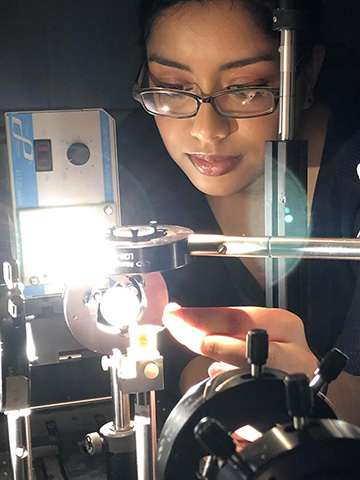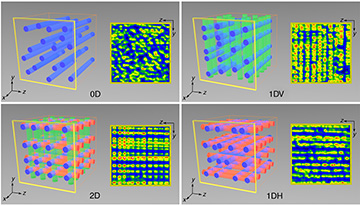
McMaster grad student Fariha Mahmood is part of a team that developed a system for performing digital computation with incoherent light shone through a polymer cube. [Image: McMaster University]
A research team at McMaster University, Canada, has developed a soft, photoresponsive polymer cuboid that can interact with binary-encoded, incoherent light to perform binary arithmetic, simple pattern recognition and other computation (Nat. Commun., doi: 10.1038/s41467-019-10166-4). The material works through a nonlinear interaction in which incident light creates thousands of channels of altered refractive index in the material that act as waveguides, and that can interact to perform calculations in individual volume elements (voxels) of the 3-D cuboid.
The light–matter computation system demonstrated by the group is still very much at the proof-of-concept stage, with some significant research hurdles to overcome. Nonetheless, the team believes the scheme is sufficiently general to apply to other nonlinear materials, and possibly to open up new approaches to computation using incoherent-light sources such as LEDs.
Math from materials
The quest for “materials that compute” has spurred considerable scientific work in recent years. The lab of OSA Fellow Nader Engheta at the University of Pennsylvania, USA, for example, has demonstrated specialized metamaterials that can interact with optical waves to perform analog computation, including calculus operations such as first-order spatial differentiation and solution of integral equations. And chemist Anna Balzas and colleagues at the University of Pittsburgh, USA, have developed piezoelectrically sensed self-oscillating gels that, when coupled in series and synchronized, can perform certain pattern recognition tasks.
The team at McMaster, led by chemistry professor Kalaichelvi Saravanamuttu, came up with a different polymer system that could perform computation using light. At the heart of the system is a photopolymerizable organosiloxane colloid, or sol, which the team packaged into transparent glass cuvettes of 10×10×5 mm, the cuboids that constitute the workhorses of the computing system.
Incoherent light shone on the face of a cube of the photoresponsive material results, through a modulation instability, in the formation of waveguides of altered refractive index that pass through the material. By binary encoding of the incident light field into light and dark bands, shining the encoded light on different faces of the cube, and by reading the output pattern of the light through the resulting interacting waveguides, the McMaster team was able to perform computational operations such as binary arithmetic. [Image: A.D. Hudson et al., Nat. Commun., doi: 10.1038/s41467-019-10166-4, CC-BY 4.0] [Enlarge image]
Order via instability
When incoherent incident light hits one face of the cuboid, it initiates a process of free-radical polymerization in the sol, changing the local refractive index along the light’s propagation axis. As the index changes build up, the accumulation of associated noise triggers a modulation instability—analogous to those that have been cited in soliton physics and the formation of optical “rogue waves”—that ultimately results in the creation of thousands of filaments crossing the cuboid in the light’s propagation direction. Those filaments act as waveguides that channel the light through the cuboid as bound optical modes.
The team found that, by shining light on three orthogonal faces of the cuboid, and by digitally encoding the incident light into binary-encoded, alternating light and dark bands, it was able to perform binary addition and subtraction operations using the material—without any additional external energy input—by reading the light patterns that emerge from the complex 3-D distribution of filament waveguides. The researchers also used the material to perform basic recognition and transfer of light-and-dark, binary-encoded optical data, and to create specific alphabetic character shapes by processing such binary-encoded light through the photoresponsive polymer.
Some hurdles to clear
While the McMaster team has demonstrated a system that works in the lab, a number of significant hurdles will need to be overcome to get to something of potential interest for new forms and applications of computing. Perhaps the biggest stumbling block is that, in the current polymer, the filamentation process that creates the waveguides is permanent and irreversible—making the sol essentially a single-use material. The current process also proceeds at a glacial pace; creating a population of filaments in the cuboid from an incident beam can take 20 minutes or more.
Not surprisingly, with this proof of concept under their belts, Saravanamuttu and her team are now focusing on overcoming those problems by developing new soft materials with rapid, and reversible, photoresponses. They’re also looking at systems that can create even higher densities of filaments, to increase the resolution of the resulting computational system.
Meanwhile, the team sees a number of advantages to the system that should make these efforts worthwhile. The researchers note, for example, that the system can perform computations using incoherent light from a low-power source such as an LED, rather than relying on coherent light from a laser, and that it requires no additional input of electrical energy to perform computations. And the “transferability of [the polymer’s] working principles to other nonlinear materials” constitutes, in the view of the team, “a critical and powerful feature of our system,” opening the prospect of extending this singular computing scheme to other material platforms.
“We don’t want to compete with existing computing technologies,” one of the study’s authors, McMaster grad student Fariha Mahmood, said in a press release accompanying the research. “We’re trying to build materials with more intelligent, sophisticated responses.”

